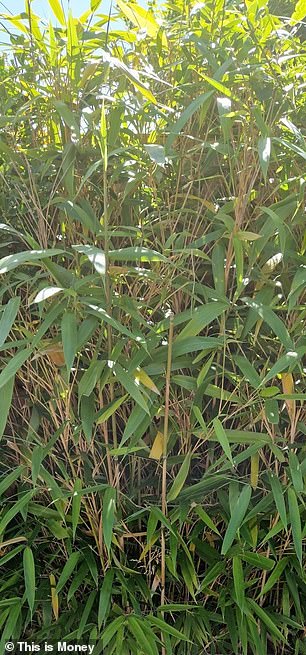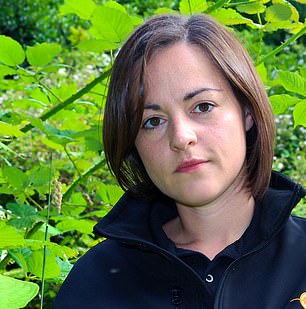We have two types of bamboo in our garden. Should these be removed?
Eight years ago we bought our current house. On both sides of the garden there is bamboo, planted by previous owners.
We are no experts but they appear to be two different species, one is near our conservatory and the other is at the back of the garden near the shed.
Recently I occasionally noticed a shoot growing through the grass at some distance from the plant.
Should we be concerned about both types of bamboo? We would like to get rid of it, but we don’t know how much it will cost and who to contact.
Could it also be a problem if we put our house on the market? Via email
What to do with bamboo: This is one of the plants in my garden – I’m not sure if I should worry about it
Jane Denton responds: Bamboos are a group of woody plants in the grass family. Although they are grasses, some bamboos are so large that they resemble trees.
Bamboo is versatile and strong and can be used to create impressive architectural structures, as demonstrated by the Arc at the Green School in Bali.
However, for homeowners and gardeners, bamboo can cause a host of problems.
The Royal Horticultural Society describes bamboo as ‘vigorous and fast growing’, with some species able to grow up to a metre a day.
If left unchecked, bamboo can grow several meters tall, become an invasive plant and spread beyond the plant’s boundaries.
The photos you have added are impressive and give you every reason to think about the impact of bamboo on your garden and property.
There is also a high risk that the bamboo could not only damage your property and that of your neighbors, but it could also significantly affect the value of your home and make it difficult to sell. Therefore, it is advisable to take action as soon as possible.
We spoke to two invasive plant experts and a real estate agent to determine the best approach.

Another variety: This is the other bamboo in our garden
Emily Grant, Director at Environet, says: There are approximately 350 species of bamboo growing in the UK. These can generally be divided into two growth forms: spreading and clumping.
Rampant bamboos have a much greater tendency to spread and can cause serious problems for homeowners, as they can form long, lateral runners underground that can reappear in new, unwanted places.
It is hard to tell from photos alone, but one of the two species you have appears to be a golden bamboo, phyllostachys aurea. This is a invasive species and we often see it growing outside of its original planting location.
The second species could be the arrow bamboo (pseudosasa japonica). This species grows slower, but still spreads.
Because both plants are on the border and one of the plants has already spread, the risk of infestation is high.
If nothing is done, there is a good chance that they will eventually enter adjacent properties, and this may already have happened.
Allowing bamboo to spread onto adjacent land can result in a civil nuisance liability. This means that there may be grounds for a legal claim against you if you do not take appropriate steps to address the encroachment problem.
If you leave bamboo shoots in the ground, you also run the risk of damaging your property. Shoots can spread in all directions and easily destroy your patio or garden, grow through lawns and decking, overrun flower beds and even end up in the building itself.

Knowledge: Invasive Plant Specialist Emily Grant
A professional bamboo survey can determine the extent of the problem, assess the risk of infestation, and recommend a plan to address the problem.
The quickest and most effective way would be to dig the bamboo out completely. Given the speed at which the plant can spread, it is better to take action as soon as possible.
If you want to keep the plants, for example to screen them, you can place them in a bamboo-resistant root barrier or dig them up and plant them in sturdy pots. Keep a close eye on them.
A bamboo survey by an expert costs around £300, while excavation work typically costs around £3,500, excluding VAT.
Unlike Japanese knotweed, you do not have to report the bamboo on your plot when selling your plot. However, it may be the case that a building inspection recommends further investigation.
This seems to be happening more and more as people become more aware of the risks.
Marc von Grundherr, director at brokerage firm Benham and Reeves, said: Bamboo has traditionally been a popular way to create natural privacy in gardens, however, there are a number of invasive species that can spread quickly and are difficult to control, let alone maintain.
They can even reach up to 30 feet underground and cross boundaries, which can cause problems with neighbors.
Although bamboo is now being compared to the infamous Japanese knotweed, there are currently no controls on bamboo and, unlike knotweed, you do not have to declare its presence when selling.
However, home buyers are becoming more aware and it has undoubtedly become a modern deterrent.
In terms of marketability, you want to avoid anything that could compromise the integrity of your property or the adjacent properties.
Invasive bamboo species are known to grow through masonry and damage drains, patios and cavity walls, so this species definitely falls into this category.
It can be difficult to remove and can cost up to £3,500 excluding VAT. If it is not removed, a potential buyer will undoubtedly take this into account when making an offer.
However, if you have a serious bamboo problem, the cost is likely to be much higher. In addition, the presence of uncontrollable, invasive bamboo is reported to potential buyers by inspectors.
Japanese knotweed is thought to affect house prices by around 15 per cent. And if we consider invasive bamboo, which causes similar problems, that would mean a loss of over £40,000 on the average house price today.
Ethan Lees, an expert at Surrey Bamboo Removal, says: The larger bamboo plant resembles the golden bamboo, while the smaller plant looks more like the arrow bamboo.
The golden bamboo is a concern because it is classified as a ‘running type’ bamboo. Arrow bamboo tends to clump more.

Specialist: Bamboo expert Ethan Lees
Unfortunately, despite being a popular choice due to its properties, the clump-forming bamboo species can be very invasive in desired conditions.
We have seen some of our worst problems with infestation with clumping bamboo, we see that it usually takes 12 to 15 years before it decides to go somewhere else.
The fact that you have seen shoots emerging quite a distance from the main plant system suggests that the bamboo has already penetrated other areas. It is just not visible above ground yet.
Given the location of all the bamboo in your yard, it is important to address it as soon as possible to prevent future damage to the infrastructure or prevent existing damage from getting worse.
If you want to get rid of the bamboo, it is wise to remove both plants at the same time to prevent future problems.
Under certain circumstances, digging out, repotting and installing a root barrier may be an option, but this is not always feasible due to access issues.
Although herbicide treatments are available, experience has shown that they are largely ineffective.
Bamboo can regrow from cut rhizomes no bigger than your little finger, so it is impossible to say that you can completely remove bamboo on the first try.
You want the assurance that the company will return if there is growth in the future.
Find bamboo removal experts in your area and discuss your specific situation with a professional. If you have one, talk to your gardener to see if he has any recommendations.

